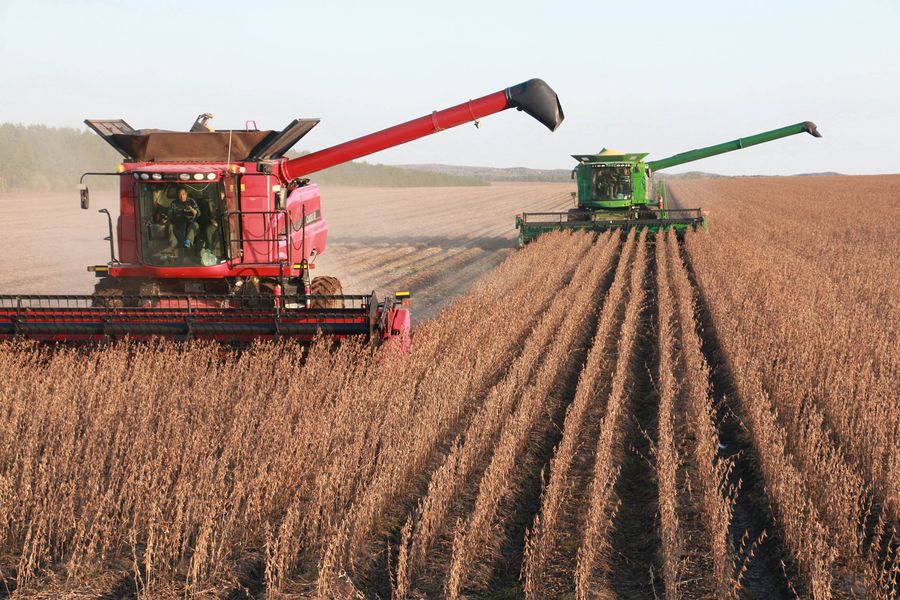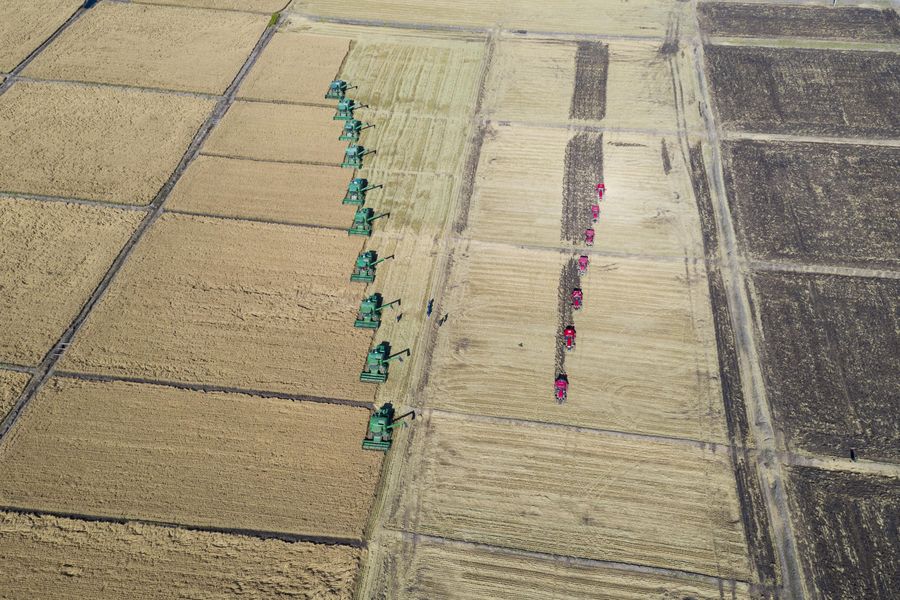China is poised to achieve a bumper grain harvest, not only securing basic food self-sufficiency but also giving steady supplies of quality grain products.
China's grain output is expected to reach over 650 billion kg for a fifth straight year in 2019, sustaining 16 consecutive years of bumper harvest, according to the Ministry of Agriculture and Rural Affairs.
HARBIN, Oct. 15 (Xinhua) -- With the adjusting of smaller corn planting areas and larger soybean growing coverage, China is poised to achieve a bumper grain harvest, not only securing basic food self-sufficiency but also providing a steady supply of quality grain products.
Combine harvesters are busy reaping crops in northeast China's Heilongjiang Province. Known as China's "grain barn," the province boasts the country's largest plantations of rice, corn and beans in vast tracts of fertile farmland.
Lin Guifang, a grain farmer in Keshan County, has just harvested 8.3 hectares of soybeans, 6.7 hectares more than last year, with a yield of 2,475 kg per hectare, he said.

Aerial photo taken on Oct. 12, 2019 shows paddy fields at Qindeli Farm in northeast China's Heilongjiang Province. (Xinhua/Xie Jianfei)
As the largest soybean producer in China, Heilongjiang's soybean planting area increased by 666,667 hectares this year to reach 4.27 million hectares in total, with this year's soybean output forecast to reach 9.3 million tonnes, according to the provincial agriculture and rural affairs department.
Earlier this year, the Dalian Commodity Exchange set up the first county-level futures delivery warehouse for state-owned grain enterprises in Sunwu County, Heilongjiang to strengthen the links between domestic soybeans and futures markets.
Xu Gang, the county chief, said the soybean delivery depot helps farmers trade online ahead of the harvest in line with their price expectations. The soybean futures help broaden the purchasing channels, while the soybean delivery warehouse contributes to avoiding the backflow of goods and reduces the transportation cost.
The planting area and yield of Japonica rice, soybeans and corn in Heilongjiang all rank first in China, with 4 million hectares of rice plantation and 5.5 million hectares of corn planting area.
Although lingering heavy rainfall in summer brought certain adverse effects, comprehensive agricultural water conservancy facilities have helped mitigate the effects on the harvest, according to the Heilongjiang Academy of Agricultural Sciences.
The provincial government has appropriated 100 million yuan (14 million U.S. dollars) this year to buy 2,600 unmanned aerial drones for assisting farming. The drones play important roles in spraying fertilizer and pesticides in places where large machinery cannot reach.

A worker loads the packaged rice at a rice processing company in northeast China's Heilongjiang Province, Oct. 12, 2019. (Xinhua/Xie Jianfei)
Wang Yuelong, director of the Hatun maize cultivation cooperative in Sunwu County, said before the harvesting, he input geographical coordinates of the paddy fields into the system of the harvester, which is currently operating around-the-clock reaping crops.
Equipped with a signal receiving apparatus, the harvester is navigated with automatic satellite positioning and a smart data monitoring and transmission system.
Heilongjiang achieved a total grain output of 75 billion kg in 2018, accounting for one-ninth of the country's total, said Li Shirun, deputy director of the provincial department of agriculture and rural affairs.
Li said comprehensive mechanization has been used in 97 percent of the farming in the province with 200,000 rural cooperatives like Hatun.

Photo taken on Sept. 20, 2018 shows farmers driving harvesters to collect soybeans at a farm in Heihe, northeast China's Heilongjiang Province. (Xinhua/Lu Wenxiang)
China's grain output is expected to reach over 650 billion kg for a fifth straight year in 2019, sustaining 16 consecutive years of bumper harvest, according to the Ministry of Agriculture and Rural Affairs.
Han Changfu, minister of agriculture and rural affairs, stressed that the country should keep enhancing agricultural technology to improve grain productivity and optimize grain structure.
China on Monday issued a white paper on food security, detailing the country's efforts in enhancing food security and expanding international cooperation in the area.
Abiding by the principle of basic food self-sufficiency based on domestic grain production, China practices the strictest farmland protection system and a strategy of sustainable farmland use and innovative application of agricultural technology to increase farmland productivity, the white paper said.
In Jiansanjiang National Agricultural Science and Technology Park in Heilongjiang, technician Luo Shaojie experiments with soil testing formulas.
The paddy field in the park is equipped with sensors monitoring data such as soil, temperature and moisture. "Using big data, we can make agricultural work more accurate to better serve farmers," he said.
To promote new planting methods, the park has organized more than 200 training sessions this year, with over 5,000 farmers trained.
Heilongjiang, which has 370 modern agricultural science and technology parks providing technology support to farming, is also home to 1,458 high-standard agriculture production bases.

Aerial photo taken on Oct. 12, 2019 shows harvesters at Qindeli Farm in northeast China's Heilongjiang Province. (Xinhua/Xie Jianfei)
Li Guocai, a farmer who runs the Junda Rice Planting Professional Cooperative, which has 267 hectares of grain fields, said he expected to see an output of 2,300 tonnes of grain this year, which is enough to feed 15,000 people a year.
Li said the cooperative raises 1,000 pigs, using their fermented manure for fertilization to develop high-quality rice.
"In the paddy fields, we raise crabs and frogs, combining farming with animal husbandry and creating a recycling chain within the ecosystem. We have basically said goodbye to chemical fertilizers, as we are self-sufficient in organic fertilizers," he said.
The eco-farms have turned out to be tourist attractions. In the city of Fuyuan, Sun Guoliang, director of the Jiucheng Rice Planting Cooperative, runs a "duck and rice" eco-park, which has become an important source of income.
"We'd love to invite people to visit the fields to see how we produce the farm produce at every step," said Li Fuqiang, another cooperative manager who raised crabs in paddy fields.
He said the rice harvested from his crab fields was sold at a higher price than that from ordinary fields.
(Video reporter: Qi Hongxin; Video editor: Liu Ruoshi)■



